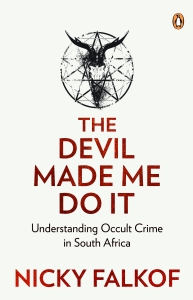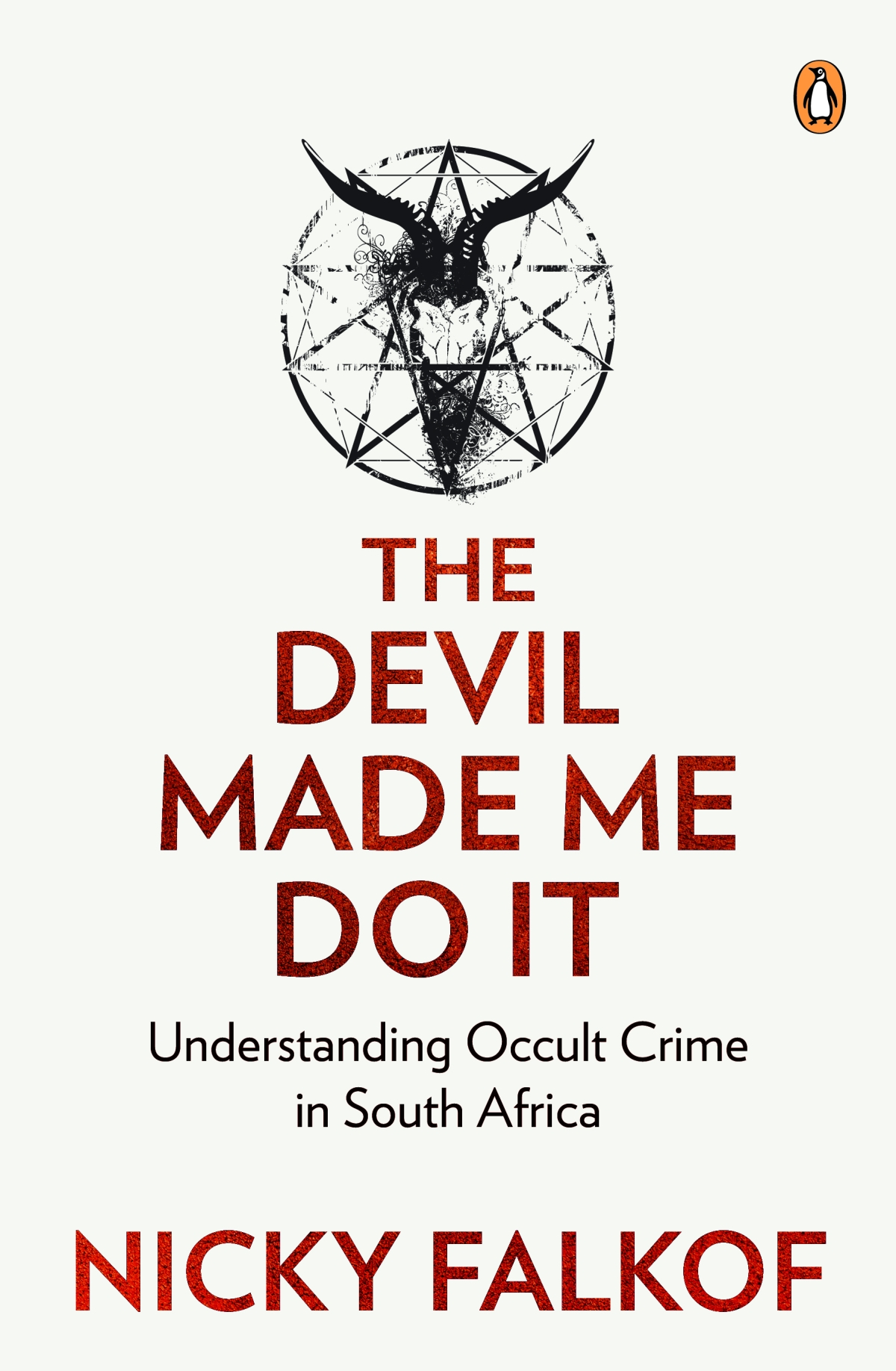
South Africa often seems gripped by occult crime – satanism, witchcraft,
muti murders, and demonic possession. But why do supernatural beliefs
hold such sway in a country facing real threats like gender-based violence,
poverty, and child abuse? The Devil Made Me Do It explores how these
beliefs intersect with race, class, and gender, and asks what they reveal
about our fractured society. From the tokoloshe killing of the 1920s to the
Krugersdorp cult murders, this gripping book unpacks the stories behind
the headlines – and what they say about power, fear, and truth in modern
South Africa. Fact or fiction? You decide.
The Problem of Occult Crime
When reading through a tabloid newspaper, browsing conversations on X and Facebook or joining one of the thousands of community WhatsApp groups that dot the country, you may be forgiven for thinking that South Africa is in the grip of a unique crime wave. Stories abound of witches and satanists, of cults and idols, of ritual murder, possession and the supernatural. Such stories are found everywhere, from government statements denying that then-president Jacob Zuma practised witchcraft to sensational headlines blaming satanists for desecrating cemeteries.
Threats and violence emerging from supernatural beliefs seem to be particularly common. Sometimes these appear in high-profile cases, such as the shocking kidnapping and murder of Hillary Gardee, the twenty-eight-year-old daughter of Economic Freedom Fighters politician Godrich Gardee, in 2022. After her body was found, both mainstream news and social media reports speculated about the involvement of muti and sangomas in her death.
In other instances, occult violence penetrates the otherwise unremarkable lives of ordinary people. In 2024, a forex trader in KwaZulu-Natal told police that he had narrowly escaped ritual slaughter after being caught up in a clever scam; that same year, a man was jailed for life in Mpumalanga after murdering his mother, whom he accused of being a witch. These kinds of stories have a powerful capacity to inspire fear.
When organisations like News24 and IOL put up Facebook posts about so-called satanist murders, they garner hundreds of comments from panicked and angry South Africans. We are, it would seem, at the mercy of a shocking explosion of occult crime. But what is occult crime really? Given its outsized place in our collective imagination, we could expect to have a clear definition for this social problem. Such an expectation would, however, be ambitious.
Few of us really think about what it might mean, or about its legitimacy. When we talk about occult crime, are we speaking about crimes perpetrated by people who believe they are under the influence of occult forces and who use these beliefs to excuse their behaviour? Or do we mean crimes that have an apparent foundation in the occult? Do we define something as an occult crime when it seems rooted in an unfamiliar spiritual or religious tradition? What kind of evidence is required to justify the designation of occult? And, perhaps most importantly, what kind of work does the term do in helping us to understand our dangerous and often frightening society?
Let me begin with a personal disclosure. I spent a large proportion of my adolescent years making runes out of tree bark, reading books about Wicca, listening to the Sisters of Mercy and giving terrible tarot readings to other gothy kids. As a group, my friends and I embodied the kind of occult-influenced teenage terror that haunted the nightmares of parents and teachers. In retrospect I can’t say whether I really believed in any of those hodgepodge rituals or whether I was just trying to freak out my high-school principal by wearing pentagram necklaces. This latter aim was much more successful than any of my attempts to contact the spirit world, thanks to a powerful panic about satanism that gripped white South Africa during the last years of apartheid and the early days of the ‘new’ democratic nation. The satanic panic played directly into our youthful rebellion. Its visual and behavioural vocabulary provided an easy shortcut for scaring the adults around us, who had been primed by years of media hysteria about the threat that satanism posed to impressionable youth.
Decades later, when searching for a topic for my doctoral thesis, I found myself wondering where all the satanists had gone, and what had happened to the fear that had impacted my adolescence so powerfully before seeming to vanish into the ether. My academic career began in earnest with a project about white fears of satanism during the late apartheid era, which I discuss in more detail in Chapter 2 of this book. South African ideas about the occult have always been part of my internal landscape, whether offering a vocabulary for teenage rebellion or a rich seam of analysis that has allowed me to think critically about race and anxiety in the society that birthed me.
Despite these attachments, however, I must state upfront that I do not believe in the supernatural. I do not believe that the Devil is stalking South Africa, or that human evil can be prevented by prayer and faith. I accept that other people believe these things, and that these beliefs serve many purposes and have many effects, some of them extremely valuable. It is not my intention here to dismiss or mock anyone else’s spiritual principles.
These can provide solace and community in a complicated world, as well as create powerful links to histories, families and ancestries. We all have the moral and constitutional right to hold whatever convictions will get us through the day, provided these don’t lead us to real-world actions that will harm or disadvantage others. And, of course, there may well be a supernatural world out there that my wide-eyed teenage self was more capable of discerning than the cynical adult I have become.
But let me be clear about a basic supposition underpinning this book: there is no global satanic plot driven by blood-drinking leftie paedophile elites, as the widespread – and quite bizarre – US meta-conspiracy of QAnon would have us believe. There are no satanist cells dotted across the country or the world that recruit vulnerable young people, teaching them to use pop music, media and technology to spread an evil message of demonic reign. Ordinary people do not suddenly become possessed by abominable forces from another world that force them to rape, steal and kill.
“It is not only monsters who commit monstrous crimes.”
The philosopher Hannah Arendt, writing about the Israeli trial of Nazi commander Adolf Eichmann, famously coined the term ‘the banality of evil’. In Eichmann in Jerusalem, she wrote: ‘Despite all the efforts of the prosecution, everybody could see that he was not a ‘monster’, but it was difficult indeed to suspect that he was not a clown. And since this suspicion would have been fatal to the whole enterprise [of the trial], and was also rather hard to sustain in view of the sufferings he and his like had caused to millions of people, his worst clowneries were hardly noticed and almost never reported.’
Among other quarrels with that process, Arendt was furious that the Israeli courts presented one man as a stand-in for the entire Nazi establishment and the complex, carefully engineered genocidal system that it developed. By refusing the temptation to classify Eichmann as a monster, and thus to define his crimes as outside of normal, everyday humanity, Arendt contended that evil is ordinary, that it is part of the normal workings of the world. Rather than being a product of a few damaged minds, the horror of the Final Solution was, she insisted, a fully functional part of Nazi social engineering and ideology: a system, if you will, rather than the scattered psychoses of specific individuals.
While Arendt’s idea is overused and frequently misunderstood, it remains insightful. Arendt helps us understand how individuals, institutions and societies process acts that are defined as evil. We tend to think of these kinds of crimes or events as somehow outside society, as not of ‘us’, relegating them to the realm of monsters, which are, of course, not only inhuman but also unusual. Similarly, philosopher Zygmunt Bauman, whose Jewish family escaped the Nazi invasion of Poland and who thus had first-hand experience of these horrors, wrote that ‘it is not only monsters who commit monstrous crimes … if it were only monsters who did, the most monstrous and terrifying of crimes we know of would not have happened’.
South African psychologist Pumla Gobodo-Madikizela makes this point in her book on apartheid death-squad leader Eugene de Kock, dubbed ‘Prime Evil’ by the press. While she never questions the horrific nature of his crimes, she resists the urge to scapegoat him as a monstrous – and thus solitary and exceptional – perpetrator, viewing him rather as part of a broader system of violent dehumanisation and white supremacy. (De Kock himself noted that those who gave him his kill orders did not see the inside of a courtroom.) The current genocide in Gaza is sometimes attributed to the warmongering tendencies of Israeli prime minister Benjamin Netanyahu, who is presented as a bloodthirsty outlier but is, in fact, simply a cog in a nationalist system built on the exclusion and dispossession of Palestinians.
Arendt’s notion of the banality of evil can help us understand what purpose the persistent South African interest in occult crime serves. We live in a violent country, with rates of murder, robbery, sexual assault and other harms that are comparable to those in war zones. Living like this is not easy; fear, stress and anxiety are sky-high, and it can be difficult to emotionally process the feeling that many of us have of being permanently at risk, permanently insecure. Thinking of evil as something monstrous – something not human, outside of society, perpetrated by people who are exceptional, and thus both unusual and easy to spot – can make us feel less vulnerable and less victimised. It is easier and, perhaps, less frightening to think that such acts are undertaken by crazed lunatics driven by demonic possession than it is to acknowledge that sometimes the most horrific violence is perpetrated by ordinary people within our societies, communities and homes.
Feminist activists and researchers have been telling us for years that in most cases the threat comes not from a faceless stranger lurking in the dark, but from somebody close to us. As South African scholar Pumla Dineo Gqola explains it, ‘Feminists across the world have always known that homes are really unsafe places for women.’ The threat is inside, not outside.
When we imagine a monstrous perpetrator, a violent, amoral criminal who operates under supernatural control or who is willing to invoke supernatural means to enrich themselves, we push the possibility of risk a few steps further away. Evil becomes conspicuous rather than banal, and thus a little less close to our daily lives. Diagnoses of occult influence help us avoid the disquieting knowledge that violence is usually enacted by people just like us: humans, not monsters.
In a similar vein, defining certain kinds of crimes as occult affects how we as a society believe we need to deal with them. When a crime is committed because of satanism, witchcraft or muti, the appropriate solution often seems to also be in the realm of the supernatural, typically something spiritual or religious. We see this repeatedly in instances of occult crime, particularly those involving young people. In the wake of supposedly ritual violence performed by a teenager or the emergence of a worrying group or trend at a school, we often find that everyone from teachers and community leaders to opinion writers and government ministers begins to call for increased prayer in schools, and uses the story to lament that society is disintegrating because Christian values are no longer widely practised.
There are, of course, many ironies in the assumption that simply injecting religion into schooling will prevent violence. In South Africa, these ironies are particularly stark, as Christianity was a fundamental element of state education all through the apartheid years. Teaching young white children about Jesus clearly did little to counteract the other teachings that were on offer, of white might and right. And it’s not just in schools that praying the Devil away is seen as a legitimate response to criminal issues. As I will show in Chapter 3, when we meet South Africa’s Occult-Related Crimes Unit (ORCU), the idea that Christian faith can counter antisocial behaviour even has a foothold within South African policing.
Extracted from The Devil Made Me Do It by Nicky Falkof is out now.
Extract: Blood’s Inner Rhyme by Antjie Krog









